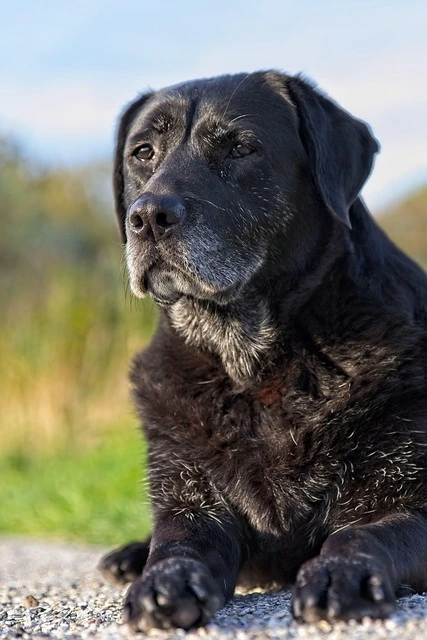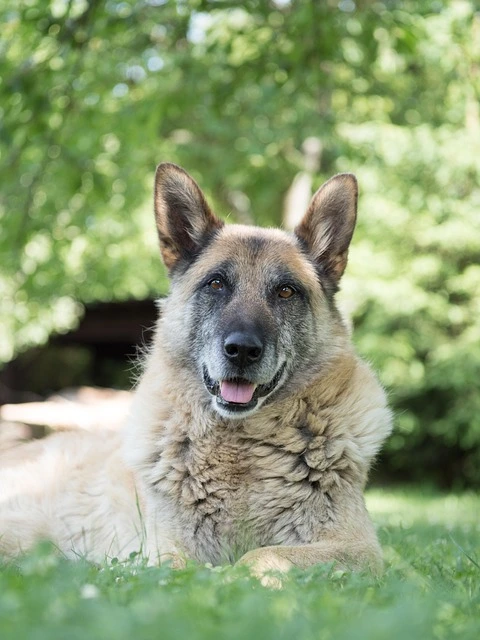Trimming your dog’s nails is a crucial grooming skill every pet parent needs. Overgrown nails can cause pain, posture problems, and even infections. The good news? With the right tools and clear guidance, learning how to trim dog nails safely at home is simple—and it can even become a bonding routine between you and your pup.
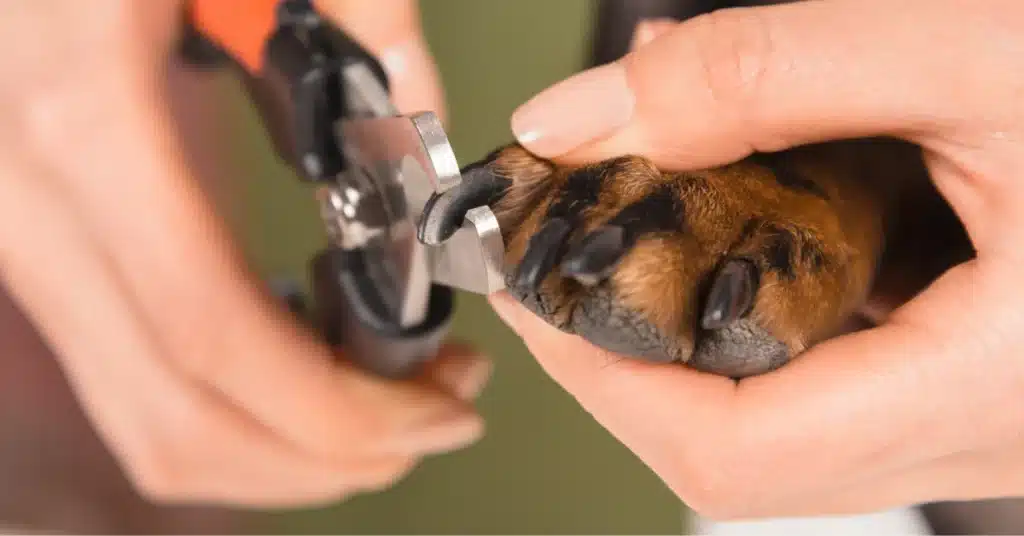
Table of Contents
Quick Answer
To trim your dog’s nails safely, hold the paw gently, place clippers at a 45° angle, and trim off small slivers until you see a white center with a dark dot—this means you’re near the quick. Smooth rough edges with a grinder, reward your dog after each nail, and never rush the process.
Why Nail Trimming Matters for Your Dog’s Health
Neglected nails aren’t just noisy—they can seriously impact your dog’s health. Long nails force your dog’s toes to spread unnaturally, altering their gait and putting stress on joints. Over time, this can lead to arthritis, spinal problems, and painful paw pad injuries.
Problems caused by overgrown nails:
- Toe splaying and joint strain
- Ingrown nails piercing paw pads → infections
- Splitting or tearing of nails → bleeding
- Difficulty walking on smooth surfaces
- Secondary posture issues and back pain
According to the American Veterinary Medical Association, regular nail trims are essential for long-term mobility and comfort.
Understanding Dog Nail Anatomy
Before you trim, it’s important to understand what’s inside your dog’s nail:
- Nail shell: Hard outer layer you cut.
- The quick: A blood vessel inside the nail (pink in light nails). Cutting it causes pain and bleeding.
- The tip: The part that extends past the quick—this is safe to trim.
Pro Tip: With black nails, you won’t see the quick. Trim in tiny slices. When you see a chalky white circle with a small dark center, stop.
Tools You’ll Need to Trim Dog Nails at Home
Having the right tools makes the process safer and easier.
Best Nail Clippers
- Small/medium dogs (under 50 lbs): Safari Professional Nail Trimmer sharp, durable & easy to control.
- Large dogs (over 50 lbs): Millers Forge Heavy-Duty Clippers strong, safe, handles thick nails easily.
Nail Grinders
Grinders smooth rough edges and are especially helpful with black nails. The best choice is : Dremel PawControl 7760-PGK Dog Nail Grinder and Trimmer quiet, cordless, with protective guard.
Safety Essentials
- Styptic powder: Stops bleeding if you cut too short.
Kwik Stop Styptic Powder. - Treats for reward: Build positive associations.
Zuke’s Mini Naturals Training Treats. - Non-slip mat & towel: Keeps your dog steady and comfortable.
Pet 2-in-1 Dog Towel & Mat.
Step-by-Step Tutorial: How to Trim Dog Nails
This is the exact process I teach new puppy parents and seasoned owners alike.
Step 1: Preparation
- Choose a quiet, well-lit space.
- Lay down a non-slip mat.
- Gather clippers, grinder, styptic powder, and treats.
- If your dog is energetic, give them a short walk or play session first.
Step 2: Paw Handling Training
Many dogs dislike paw touches. Build comfort before trimming:
- Massage paws daily, reward calmness.
- Touch each nail, give a treat.
- Let your dog sniff the clippers or grinder.
Step 3: Positioning Your Dog
- Small dogs: On your lap or table.
- Large dogs: Lying on their side or sitting upright.
- Helper option: One person trims, the other feeds treats.
Step 4: Trimming Technique
- Hold paw gently but securely.
- Place clippers at a 45° angle.
- Cut off small slices of the nail.
- Stop when you see the chalky ring with a dark dot (near quick).
- Use grinder to smooth edges.
Step 5: Don’t Forget Dewclaws
These “thumb nails” don’t touch the ground and grow faster. Trim them regularly to prevent painful curling.
Step 6: End on a Positive Note
Reward after each nail or paw. Even if you only trim a few nails, stop while the experience is positive.
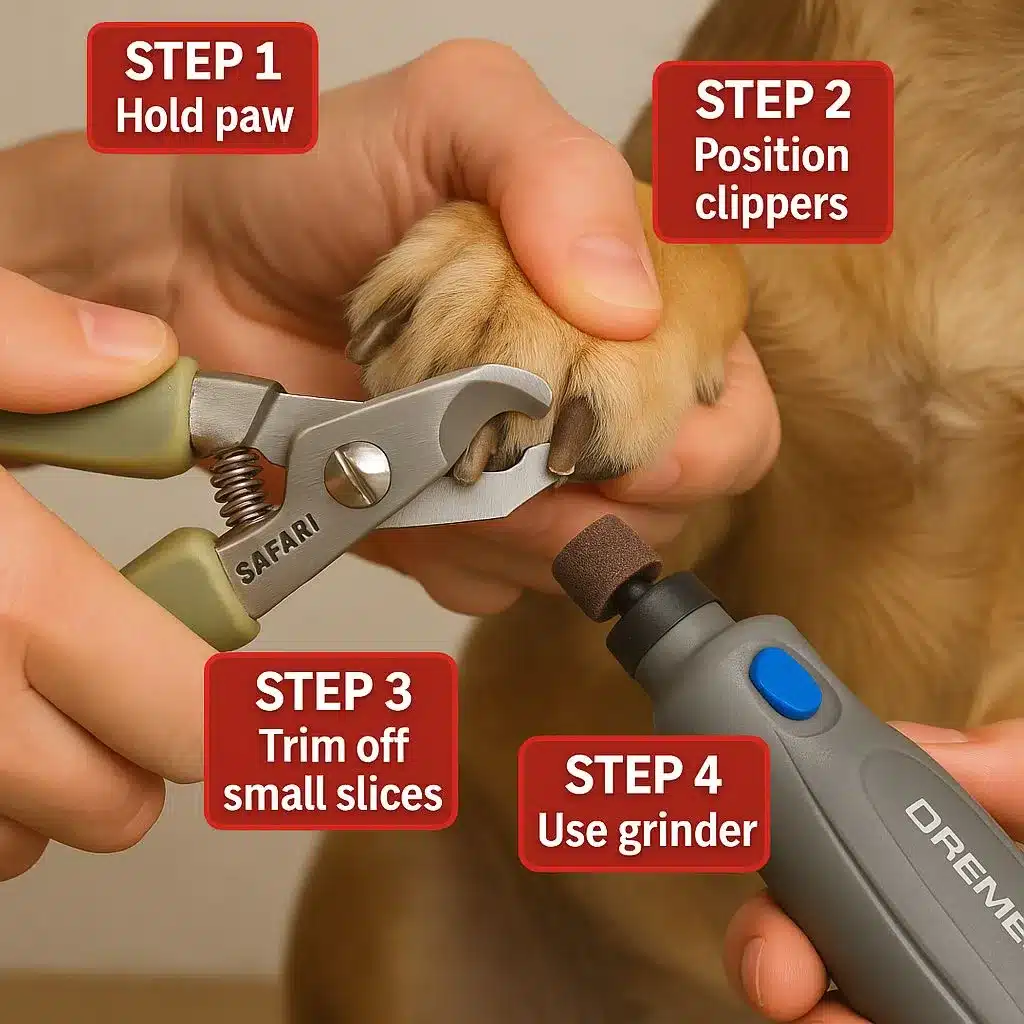
Desensitization Program for Nervous Dogs
If your dog panics at nail care, follow this 2-week training program:
- Week 1
Day 1–2: Show clippers, reward sniffing.
Day 3–4: Touch clippers to paw, treat.
Day 5–7: Make clipping sounds (snap spaghetti), reward calmness. - Week 2
Day 1–3: Hold paw while making clipping sounds, reward.
Day 4–5: Place clippers on nail without cutting, treat.
Day 6–7: Trim one nail tip. Reward generously!
Calming Techniques That Work
- Peanut butter distraction: Spread on a lick mat at nose height.
- Exercise before trimming: A tired dog is calmer.
- Timing: Try after meals or during nap time.
- Relaxing environment: Play soft music, use lavender scents.
Check our complete guide on dogs anxiety: Dog anxiety solutions.
Common Mistakes to Avoid
- Cutting too much at once → risk of bleeding.
- Using dull clippers → nails splinter, painful.
- Restraining too tightly → creates panic.
- Ignoring stress signs → trembling, pulling away, panting.
What to Do If You Cut the Quick
Stay calm—it’s fixable.
- Apply styptic powder directly to the nail tip.
- Hold pressure for 10–15 seconds.
- Reassure your dog with treats and a calm voice.
- If bleeding doesn’t stop after 10 minutes or the nail splits, call your vet.
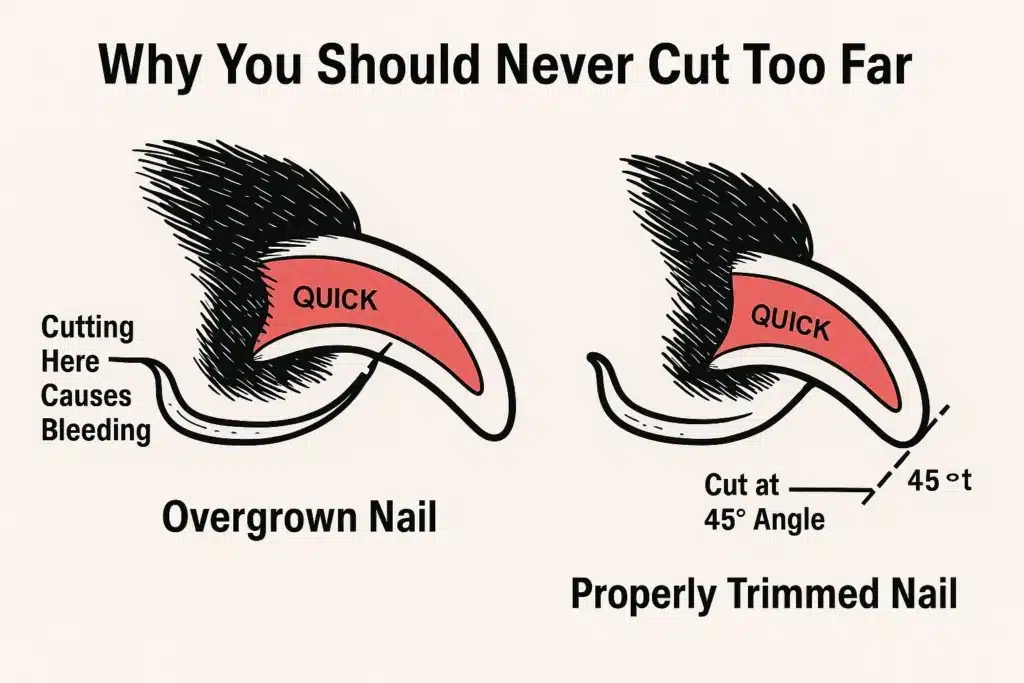
How Often Should You Trim Dog Nails?
Most dogs need a trim every 3–4 weeks. But it depends:
- Puppies: Every 2–3 weeks.
- Active dogs on pavement: Natural wear may reduce frequency.
- Indoor/senior dogs: Nails may grow faster, needing more frequent trims.
Rule of thumb: If nails touch the floor or you hear clicking, it’s time.
Breed-Specific Considerations
- Small breeds (Yorkies, Chihuahuas): Thin, delicate nails → frequent small trims.
- Large breeds (Labs, Shepherds): Thick nails → heavy-duty clippers essential.
- Working/sporting breeds: Often wear nails naturally, but dewclaws always need attention.
- Flat-faced breeds (Bulldogs, Pugs): Keep sessions short—watch breathing.
When to Call a Professional
Call a vet or groomer if:
- Your dog shows severe anxiety or aggression.
- Nails are so overgrown they curl into paw pads.
- You’ve cut the quick multiple times and your dog resists nail trims.
Professional groomers and vets have the tools, training, and, if needed, safe sedation methods.
FAQ: Dog Nail Trimming
Can I use human clippers on my dog?
No—dog nails are thicker and curved differently. Use pet-specific clippers.
What if my dog has black nails?
Trim in tiny increments. Stop when you see a chalky white ring and dark dot.
How young can I start trimming puppy nails?
As early as 8 weeks. Start slow, lots of treats.
Do dewclaws need trimming?
Yes—since they don’t wear down naturally, they can curl painfully.
Clipper vs grinder: which is better?
Clippers are fast; grinders are safer for beginners and smooth the edges.
Conclusion
Trimming your dog’s nails doesn’t have to be stressful. With the right tools, step-by-step approach, and plenty of rewards, you can safely maintain your dog’s nails at home.
Remember: short, healthy nails mean better comfort, posture, and mobility for your dog. Start slow, celebrate progress, and don’t hesitate to ask a groomer or vet for help if needed.
🐾 Healthy nails = a happier, healthier dog.
